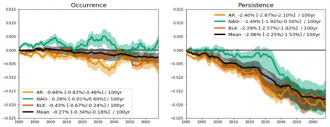| ← prev The benefits of a seamless approach to prediction |
Contents |
next → Imprecise, not inaccurate, weather forecasting |

Kristian Strommen
Jesus College, University of Oxford, UK
The idea of weather regimes is to ask if the complex dynamics of the Euro-Atlantic winter circulation can be approximated as Markovian transitions between a small number of basic states (the ‘regimes’). This idea goes back to at least the 1950s, but was given considerable impetus by the discovery by Ed Lorenz of the Lorenz ‘63 system. While most famous for its exemplification of chaos, it also exhibits clear bimodality, and is one of the most well studied examples of a dynamical system with regimes, where the two regimes correspond to the two wings of the butterflies.
In two highly influential papers in the 1990s, Palmer studied the effect of adding a forcing term to the equations defining the Lorenz ‘63 system (Palmer, 1993). He observed that irrespective of the forcing, the two regimes don’t change (i.e., the wings of the butterfly don’t move position in phase space), but that the amount of time spent by the system in either regime changes: if the forcing vector is pointing in the direction of one of the regimes then the system spends more time there. He then made the remarkable hypothesis that the same is true in the Euro-Atlantic. That is, given a forcing in the climate system (such as global warming or a tropical sea surface temperature anomaly), the Euro-Atlantic regimes stay the same but that the amount of time spent in the different regimes changes. The ‘Palmer Hypothesis’ thereby reduces the question of how the Euro-Atlantic responds to forcing to the question of understanding a small handful of numbers (the regime occurrence shifts).
The Palmer Hypothesis has been hugely influential in the study of Euro-Atlantic dynamics. The hypothesis holds to very good accuracy on sub-seasonal to seasonal time scales, where sources of midlatitude forcing (e.g. from the Madden-Julian Oscillation) are well known to force occurrence shifts of Euro-Atlantic weather regimes, a fact routinely made use of by forecasters (including in industry). A basic consequence of the hypothesis is that in order for a forecast or climate model to simulate the correct response to forcing, it crucially needs to have an accurate regime structure. However, models are well known to exhibit often considerable biases in their regime variability, such as underestimating regime persistence, implying that the response to forcing in models may be highly biased even if the forcing itself is entirely accurate. One example of this relates to the so-called ‘signal-to-noise paradox’, which suggests that seasonal-to-decadal forecast models are systematically underestimating the response of the jet to teleconnections. In analysis carried out by the author and Palmer (Strommen and Palmer 2019), it was shown that systematic biases in regime persistence is one possible explanation of this ‘paradox’. This analysis relies in an essential way on the validity of the Palmer Hypothesis. Palmer’s work has also highlighted that regime biases are often reduced by increasing the spatial resolution of the model.

Understanding the validity of the Palmer Hypothesis with regards to global warming has been more challenging, since classical methods of regime identification typically produce regime patterns that are not stable on decadal time scales (thereby violating the hypothesis). However, in recent work by Dorrington, Fabiano and the author (Dorrington et al., 2022), an improved method for identifying regimes has been proposed. By identifying the variability coming from the speed of the eddy-driven jet as being a source of Gaussian noise which is ‘transverse’ to the non-linear regime variability, three so-called ‘geopotential jet regimes’ can be identified. These correspond to an Atlantic Ridge, a Greenland block and a Scandinavian block, and are extremely stable both across the 20th century and in CMIP6 future projections even under severe warming scenarios. Figure 1 shows minimal changes to regime occurrence, but dramatic shifts in persistence. Thus, we find that the Palmer Hypothesis appears to hold also in the case of global warming, provided one takes into account persistence as well as occurrence. We remark that there is nothing remotely obvious about this result, which validates Palmer’s key insight to take the behaviour of Lorenz ‘63 deadly seriously.
| ← prev The benefits of a seamless approach to prediction |
↑ top | next → Imprecise, not inaccurate, weather forecasting |
